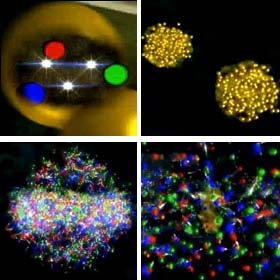Big Bang Conditions Created in Lab

This story was updated at 11:02 a.m. ET
WASHINGTON – By smashing gold particles together at super-fast speeds, physicists have basically melted protons, creating a kind of "quark soup" of matter that is about 250,000 times hotter than the center of the sun and similar to conditions just after the birth of the universe.Scientists reported in 2005 that they suspected they had created this unique state of matter, but for the first time they have verified that the extreme temperatures necessary have been reached.
"This is the hottest matter ever created in the laboratory," Steven Vigdor, associate laboratory director for nuclear and particle physics at the U.S. Department of Energy (DOE)'s Brookhaven National Laboratory in Upton, N.Y., said Monday at a meeting of the American Physical Society in Washington, D.C. "The temperature is hot enough to melt protons and neutrons."
The gold particles used in the experiment were only the nuclei — the positively-charged part of the atom made of protons and neutrons. Two sprays of gold nuclei were accelerated in opposite directions along a circular track in an underground "atom smasher" called the Relativistic Heavy Ion Collider (RHIC) Brookhaven.
Traveling along this 2.4-mile-long (3.9 km) circle, the gold nuclei were accelerated to near the speed of light. When two of these particles smashed into each other, their collisions produced such huge amounts of energy that the matter was heated up to about 7 trillion degrees Fahrenheit (4 trillion degrees Celsius).
These scorching conditions are enough to melt the protons and neutrons into their constituent parts — namely fundamental particles called quarks and gluons.
This soup of quarks and gluons is thought to have filled the universe a few microseconds after the Big Bang that may have created it about 13.7 billion years ago. After that point, the matter would have cooled and condensed to form the protons and neutrons that make up the matter we see today.
Sign up for the Live Science daily newsletter now
Get the world’s most fascinating discoveries delivered straight to your inbox.
"This research offers significant insight into the fundamental structure of matter and the early universe, highlighting the merits of long-term investment in large-scale, basic research programs at our national laboratories," said Dr. William F. Brinkman, director of the DOE Office of Science. "I commend the careful approach RHIC scientists have used to gather detailed evidence for their claim of creating a truly remarkable new form of matter."
The soupy cauldron of fundamental particles lasted less than a billionth of a trillionth of a second. But that was enough time for physicists to measure its properties and temperature using a detector built around the collision site.
The temperature measurements came via photons, or bits of light, that were emitted shortly after the nuclei crashed into each other.
"This was an extraordinarily challenging measurement," said Barbara Jacak, a professor of physics at Stony Brook University in Stony Brook, N.Y. and spokesperson for the PHENIX collaboration, one of RHIC's four experiments.
Somewhat surprisingly, the strange state of matter behaves like a liquid, though earlier predictions suggested it would act more like a gas.
"We know that this is a liquid, but we need to find out why it's a liquid, and what role did its free-flowing nature play in the early universe?" Jacak said.
Physicists may have a chance to study an even hotter state of matter once the world's largest particle accelerator, the Large Hadron Collider near Geneva, Switzerland, starts operating at full speed. Collisions in that machine could produce temperatures two or three times hotter than the recent experiment, Jacak said.
- The Strangest Little Things in Nature
- Will the Large Hadron Collider Destroy Earth?
- Top 10 Greatest Mysteries in Science










